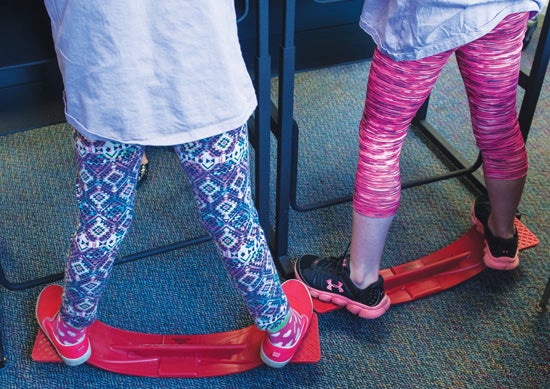Helping Wigglers Become Learners

Study helps second-graders move without disrupting class
The second-graders at West Kingston Elementary School in Rhode Island were models of scholarly focus, reading silently and intently. At the same time, they wobbled in their seats, pedaled their legs under their desks or swayed on balance boards.
And no one was asking them to sit still. That’s because University of Rhode Island researchers were studying the effects of movement on learning and language over four weeks in May.
“It’s everything we got in trouble for when we were kids,” says Emily Clapham, associate professor of kinesiology.
Kinesthetic classrooms, as they’re called, are not new, but the URI project is breaking new ground by measuring language patterns and usage in the context of movement. No other school is studying a kinesthetic classroom in a controlled manner, and no other school is looking at connections between movement, language and being on task, the researchers said.
Clapham and fellow researcher Michelle Flippin, assistant professor of communicative disorders, outfitted the school’s three second-grade classrooms with standing desks, bouncy foot rests, exercise balls, pedal desks, balance boards and learning stools—all of which allow kids to be in motion while they learn.
The researchers analyzed data from pedometers the children wear and recorded observations of whether the 43 children in the three classrooms are on or off task at a given time. They took baseline measurements of behavior and academic focus before installing the equipment, then collected data weekly. They removed the equipment for a week, recorded more data, and then re-installed the equipment to continue the research. Meanwhile the children filled out weekly surveys assessing their own behavior and learning, as did the parents, Clapham said.
“We will have a wealth of data, so we will have a good idea of whether this is improving student focus as well as which piece of equipment works best for each individual student,” Flippin said.
The community at West Kingston Elementary School didn’t need to wait for research findings to offer their endorsements. “Oh my gosh, I love it,” said teacher Caighln Perrin. “We have a very rigorous curriculum, so for them to be able to move and make their own choices is super. They are ready to work, willing to work and motivated. And for some it even helps their confidence.”
The children will quickly tell you which piece of furniture they like best. “My favorite is the standing desk. When you move, it exercises you and it helps you focus,” one girl offered.
“You can kind of move around a little bit. If you get tired of sitting down, you can stand up and get a little stretch,” one boy explained.
“It never used to be like this,” Perrin said, looking around the quiet room of attentive readers. “It makes such a difference for them to be able to move.”
And more students will get to experience that difference in the fall. The school gets to keep the equipment.
 Home
Home Browse
Browse Close
Close Events
Events Maps
Maps Email
Email Brightspace
Brightspace eCampus
eCampus


